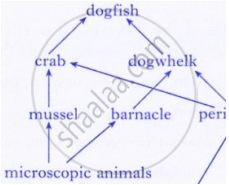Advertisements
Advertisements
प्रश्न
A food chain consists of fish, larvae, phytoplanktons and birds. The level of pesticides in water in which the fish, larvae and phytoplanktons live is quite high.
Which organism will have the maximum amount of pesticides accumulated through the food chain? What is this process known as?
उत्तर
The birds will have the maximum amount of pesticides accumulated in them through the food chain. This process is known as biomagnification.
APPEARS IN
संबंधित प्रश्न
Give reason to justify the following: Flow of energy in a food chain is unidirectional.
Write one or two word for the following statement/definition :
Each level of food chain where transfer of energy takes place
The following statement is true or false :
Only 10 per cent of the light energy given by the sun is available for transfer at each higher trophic level in a food chain.
Which common pesticide has accumulated in human body in considerable amounts?
Calculate the amount of energy that will be available to big fish in the following food chain, if 10,000 J of energy is available to small algae from the sun :
Small algae → Zooplankton → Fish → Big fish
The ten per cent law is associated with
(a) transfer of energy from various trophic levels to decomposers in a food chain
(b) transfer of ATP energy into muscular energy
(c) transfer of chemical energy from one organism to another
(d) transfer of sun's energy to the organisms called producers.
What are decomposers? What will be the consequence if the decomposers are completely eradicated from an ecosystem? Give justification in support of your answer.
Observe the food web and answer the questions given below:

Why do all food chains start with plants?
In a food chain, the third trophic level is always occupied by
In the following food chain, only 2J of energy was available to the peacocks. How much energy would have been present in Grass? Justify your answer.
GRASS → GRASS HOPPER → FROG → SNAKE → PEACOCK
